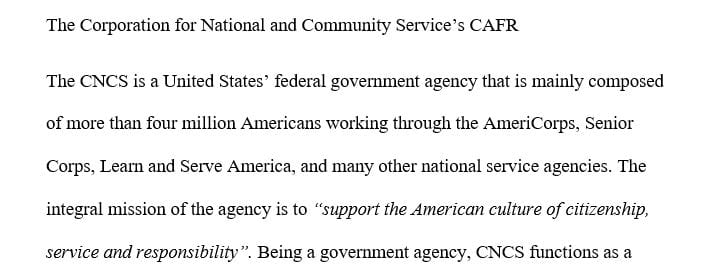Analyze an organization’s comprehensive annual financial report (CAFR) and explain its value to the organization.
Question 1:
Financial reports tell the story of an organization within a fiscal year. Annual financial reports are extremely valuable to government organizations because they give both the administrators in the organization and the public who are funding the organization a sense of where revenue is going.
In this Discussion, you analyze an organization’s comprehensive annual financial report (CAFR) and explain its value to the organization.
Review this week’s Learning Resources and reflect on the responsibility of government organizations to provide accurate financial reports to the public. Then, select a public organization and a specific CAFR from the selected organization. Public organization budgets are required by law to be available. An Internet search will yield an annual budget for your specific organization.
With these thoughts in mind:
Post by Day 4 a brief description of the organization you selected. Then, provide an analysis of that organization’s CAFR. In your analysis, explain what the report tells the stakeholders of the organization and the value of the report to the organization.
Be sure to support your posting and responses with specific references to the Learning Resources.
READINGS
Mikesell, J. L. (2014). Fiscal administration: Analysis and applications for the public sector (9th ed.). Boston, MA: Wadsworth.
Chapter 2, “The Logic of the Budget Process” (pp. 38–83)
Genito, M. (2013, February). Back to basics: An overview of governmental accounting and financial reporting. Retrieved from http://www.gfoa.org/sites/default/files/GFR_FEB_13_48.pdf
Governmental Accounting Standards Board. (2014). Retrieved from http://www.gasb.org/
Internet Center for Management and Business Administration, Inc. (2010). Double-entry bookkeeping. Retrieved from http://www.quickmba.com/accounting/fin/double-entry/
Question 2:
The legislative branch does not work in a vacuum. Instead, Congress crafts legislation with the full knowledge that the other two branches of government have the ability to limit the power of the legislative branch. However, checks and balances are a two-way street: the U.S. Constitution also delegates powers to the legislative branch to limit the powers of the judiciary and executive branches. Understanding these checks and balances is important from a constitutional perspective. It also gives you some insight into the constraints that members of the House and Senate are cognizant of as they go about the process of constructing public policy.
Think about the interactive constraints and powers of the legislative branch in relation to the judicial and executive branches. Consider, for example, how the budget process gives power and/or places restraints on the legislative branch of government. Also consider how the powers of the legislative branch might serve as a check on the policymaking powers of the judicial and executive branches.
Select one constraint and one power of the legislative branch of government. Consider how you might explain each. Think about how the power you selected specifically serves as a check on the other branches of government.
With these thoughts in mind:
Post by Day 4 an explanation of one constraint on the policymaking powers of the legislative branch (for non-U.S. students, you may consider the legislative body of your home country). Then explain one power that allows the legislative branch to serve as a check on the policymaking powers of the executive and judicial branches.
READINGS
Anderson, J. E. (2015). Public policymaking: An introduction (8th ed.). Stamford, CT: Cengage Learning.
Chapter 5, “Budgeting and Public Policy” (pp. 180–224)
Guess, G. M., & Farnham, P. G. (2011). Cases in public policy analysis (3rd ed.). Washington, D.C.: Georgetown University Press.
Chapter 4, “Forecasting Policy Options” (pp. 153–237)
Larocca, R. (2011). The bicameral context of presidential agenda setting. Congress & the Presidency, 38(2), 171–194.
Retrieved from the Walden Library databases.
Congress.gov. (n.d.). Retrieved April 28, 2014, from http://beta.congress.gov/
Library of Congress. (n.d.). Bills, resolutions. Retrieved April 28, 2014, fromhttp://thomas.loc.gov/home/bills_res.html
Each Question has to be 300-500 APA format
Answer preview to analyze an organization’s comprehensive annual financial report (CAFR) and explain its value to the organization.

602 Words

